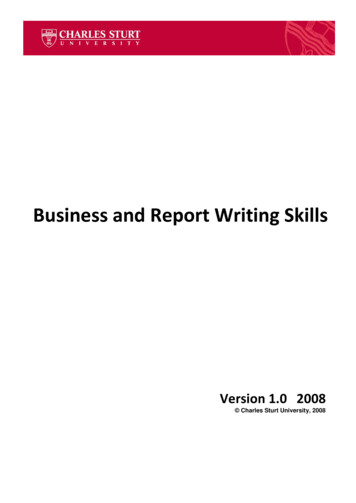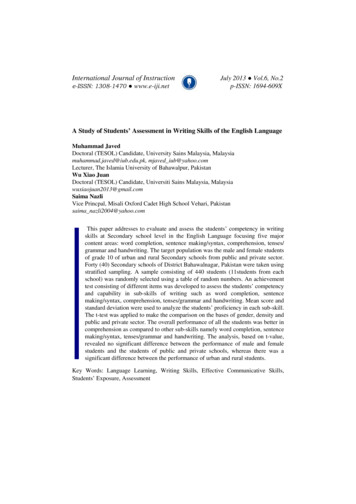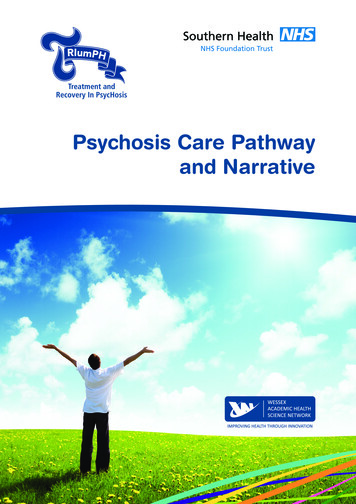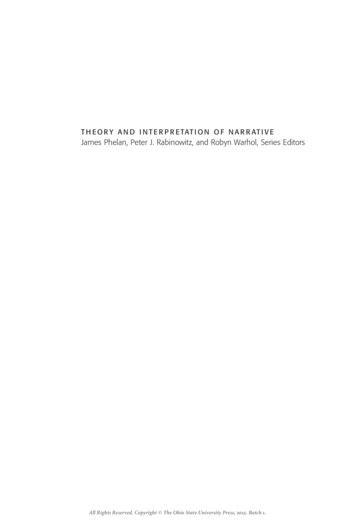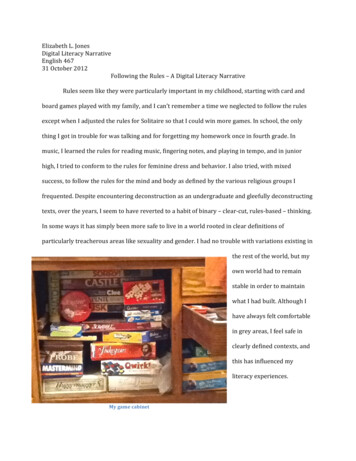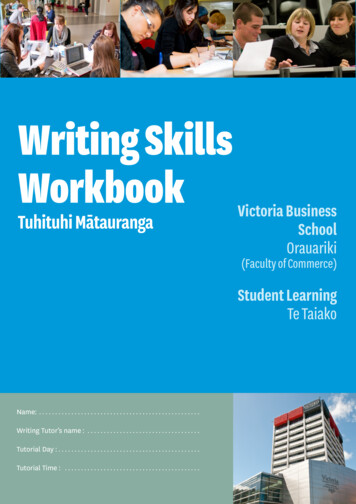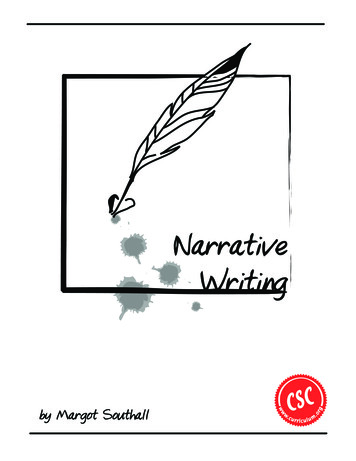
Transcription
Narrative WritingContentsUnit 1: Writing Effective Story BeginningsLesson 1: Identifying Four TechniquesLesson 2: Revising an Ineffective Story BeginningLesson 3: Establishing Setting and PlotLesson 4: Revising a Beginning Using an Alternative TechniqueLesson 5: Writers’ Workshop — Revising a Writing SampleUnit 2: Writing Effective Story EndingsLesson 1: Identifying Four TechniquesLesson 2: Revising an Ineffective Story EndingLesson 3: Revising an Ending Using an Alternative TechniqueLesson 4: Writers’ Workshop — The “Before and After” FormatUnit 3: Writing Detail and DescriptionLesson 1: Identifying the Components of Effective Descriptive WritingLesson 2: Detail Generating QuestionsLesson 3: Describing a Character’s Emotions, Thoughts, and FeelingsLesson 4: Revising a Brief, General Description with Specific DetailLesson 5: Writers’ Workshop — Revising a Writing SampleUnit 4: Writing a Main EventLesson 1: Identifying the Components of a Fully Expanded Main EventLesson 2: Expanding a Story SummaryLesson 3: Composing A Fully Expanded Main EventLesson 4: Writers’ Workshop — Revising a Writing SampleUnit 5: Writing to a PromptWriters’ Workshop — Completing a Story Within a Timed FormatUnit 6: Short-Term Writing ProjectsCompleting a Story Using a Writing Process ApproachAcknowledgementThe Curriculum Services Canada Foundation provided financial support to the writer of this resourcethrough its Grants and Awards Program for Teachers. 2001 Margot Southall1
IntroductionThe purpose of the narrative writing program is for students to increase their effectiveness aswriters. This goal is achieved by applying specific skills or techniques in each of the followingfour components of a narrative story:An Effective Story BeginningA Satisfying Story EndingDetail and DescriptionAn Expanded Main EventProcess writing can often be frustrating for many students. This program provides instruction inspecific techniques so that revisions are reduced and the clarity of students’ writing increases.The techniques are based on those used by adult authors of narrative text, presented in astep-by-step format to meet the needs of elementary students.Units 1 – 4The units are sequenced in order of difficulty. The beginning and ending of a story are theeasiest to write and revise. These units are followed by exercises that focus on generatingdescription and detail. This step is necessary before students can write a fully expanded mainevent that includes action, dialogue, and description. Lessons in each of these four unitsprogress from identifying the techniques authors use, then revising a given prompt, and finallyapplying the practised techniques to a piece of the student’s own writing. Students comparethe original and revised pieces of writing in a “Before and After” format to demonstrate thepower of revision.Units 5 – 6Unit 5 requires the students to apply the skills from each of the preceding four units tocomplete a narrative piece in response to a provided prompt. This task provides explicitpractice in writing to a prompt within a set timeframe. A planning form and timeline isprovided to assist students in completing each component of the story within 45 minutes. Byhaving the whole class write to a common prompt, the teacher is able to assess studentprogress in each of the skills.Unit 6 provides a framework and timetable that requires students to complete a narrative storyover 6 – 7 days. Each step in the writing process is outlined as a guideline for student writing.Narrative StructureWhen we examine the underlying pattern of narrative stories we find two common types:1. Character-Problem-Solution Narrative: In this type of narrative the emphasis is on a maincharacter who undergoes a problem or struggle brings about a solution grows and changes as a result of the struggle and solution2. Personal Experience Narrative: These narratives are told in the first person and emphasize 2001 Margot Southall2
an interesting experience rather than a character description and detailAs you complete each unit, provide examples for each of these two types of narratives andhave students apply the practised skills to writing and revising each one.Literature Models and Curriculum ConnectionsExcerpts from specific novels are cited as examples in each unit. The teacher may choose touse these examples or select excerpts from novels that they have studied with the class. Manyexercises suggest that teachers have students apply the new skill to revise a prompt reflectinga current Social Studies or Science topic. To do this, the teacher may adapt the BlacklineMasters so that they refer to a narrative that takes place in contexts such as medieval times,an ancient civilization, or during the early settlement of Canada.Individualizing the Program: Accommodations and ModificationsEach component of the writing skills program presents specific techniques in a scaffoldedformat, with the teacher first modelling the skill, then guiding the students in practising the skill,and finally providing opportunity for independent application.The following teaching strategies have been incorporated throughout the program to addressthe needs of the range of developmental levels in any one classroom and to provide supportfor students experiencing difficulty with the reading and writing process.Read-Aloud: The teacher reads the literature selection to the students to model the requiredtechnique.Pre-writing Activities: Each lesson addresses background knowledge and understanding of thespecific writing skill during the “Introducing the Skill” and “Modelling the Skill” sections.Shared and Modelled Writing: The teacher records student input in a shared-writing formatand models the composition process, verbalizing each step in a “Think-Aloud” approach.Co-operative Learning: This format, which provides access to peer support in a small group,may be used for the completion of each written response.Graphic Organizers: Organizers assist development of a main idea and provide anorganizational structure for planning a complete piece of writing.Focus on Process — a Series of Small Successes: A step-by-step approach provides a series ofsmall successes to encourage the growth of confidence and skills.Risk-Taking Is Encouraged: Most of the practice activities focus on revising a prompt ratherthan individual student work, which removes the fear of risk-taking associated with having yourown work evaluated. Only when the skill has been thoroughly practised in this manner arestudents expected to apply one skill at a time to revise their own writing.ReferencesGardner, John. The Art of Fiction: Notes on Craft for Young Writers. Vintage Books, 1991.Hood, Ann. Creating Character Emotions. Writers’ Digest Books, 1998.Kress, Nancy. Beginnings, Middles & Ends. Writers’ Digest Books, 1999. 2001 Margot Southall3
———. Description. Writers’ Digest Books, 1999.———. Dynamic Characters: How to Create Personalities That Keep Readers Captivated.Writers’ Digest Books, 1998.Mariconda, Barbara. The Most Wonderful Writing Lessons Ever. New York: Scholastic, 1999.McClanahan, Rebecca. Word Painting: A Guide to Writing More Descriptively. Writers’ DigestBooks, 2000.Rubie, Peter. The Elements of Storytelling: How to Write Compelling Fiction. John Wiley & Sons,1995. 2001 Margot Southall4
Unit 1: Writing Effective Story BeginningsLesson 1PurposeAnalyse story beginnings from literature as models for student writing.Identify four techniques for a compelling beginning: action, dialogue and/or exclamation, thought or question, and sound effect.Materials Key novel: The BFG by Roald Dahl. Other examples include Hatchet by Gary Paulsen, Lostin the Barrens by Farley Mowat, Amish Adventure by Barbara Smucker, Bridge to Terabithiaby Katherine Paterson, Blue Heron by Avi, Poppy by Avi, Cricket in Times Square by GeorgeSelden, and Charlotte’s Web by E.B. White. Chart paper and markers Blackline Masters 1 – 8Teacher PreparationReview the chapter beginnings in the novels (listed under “Modelling the Skill”) and the technique that these passages represent.Prepare a chart of the four techniques entitled “Effective Story Beginnings.”Introducing the SkillBuilding Background Knowledge and ExperienceDiscuss the importance of making a good impression when you first meet someone. Brainstorm and list the types of behaviour thatleave an unfavourable impression, such as avoidance of eye contact, talking only about yourself (“I , I ”), boring small talk thatnever seems to get to the point, and overly factual conversations. Relate these behaviours to the importance of establishing arapport with the audience when writing a narrative. Discuss why it is important for a story beginning to be entertaining (so that thereader is motivated to continue reading).If possible, present pieces of student writing as examples of ineffective beginnings. You may wish to use examples from previousyears or keep writing samples anonymous. Invite student observations and constructive criticism. Allow students to identify thecharacteristics of ineffective beginnings and suggest possible solutions that would capture the interest of the reader.A good beginning should grab readers’ attention, invite them in, raise questions, and arouse curiosity. In short, it should compelreaders to want to read further. Relate the beginning of a narrative to the role played by an opening act for a popular performingartist.Modelling the SkillModel Four Effective Techniques Using LiteratureProvide a selection of books with snappy beginnings. Read the first sentence(s) of a book or chapter.Discuss how the author grabs the readers’ attention. Ask students to identify the technique the author used.Point out each of the following four techniques on the chart entitled “Effective Story Beginnings”:1. An Action Put the main character in the setting doing something interesting.Literature models: “The Snatch” and “Dreams” in The BFG, Chapter 10 in 2001 Margot Southall5
Poppy by Avi2. DialogueHave the main character say something that expresses a or feeling,creates worry, or raises the reader’s interest or Exclamation curiosity.Literature models: Dialogue: “A Trogglehumper for the Fleshlumpeater,”“The Great Plan”; Exclamation and Dialogue: “The Palace” in The BFG,Charlotte’s Web by E.B. White, Chapter One3. A Thought Show what the main character is thinking or worrying about or QuestionLiterature models: Thoughts: “The BFG” and “Who” in The BFG, Chapter 3in Hatchet; Questions: “Snozzcumbers” in The BFG4. A SoundA relevant sound effect is a great attention-getting technique. Use aninteresting or unusual noise to capture the reader’s attention. Whatmight you hear if you were the character?Literature models: “The Bloodbottler” in The BFG, Chapter 1 in Bridge toTerabithia (used in exercise), Chapter 2 in The Cricket in Times SquareLiterature ExamplesAn ActionUnder the blanket Sophie waited. After a minute or so, she lifted a corner of the blanket andpeeped out. For the second time that night her blood froze to ice and she wanted to scream,but no sound came out.The Snatch” in The BFGDialogue and/or Exclamation“We’ve absolutely got to stop them!” Sophie cried. “Put me back in your pocket quick andwe’ll chase after them and warn everyone in England they’re coming.”“The Great Plan” in The BFG by Roald DahlA Thought or QuestionLife was going along okay when my mother and father dropped the news. Bam! Just like that.“We have something wonderful to tell you, Peter,” Mom said before dinner. She was slicingcarrots into the salad bowl. I grabbed one. “What is it?” I asked.Guess What Peter?” in Superfudge by Judy BlumeA SoundMario heard the sound too. He stood up and listened intently. The noise of the shuttle rattledoff into silence. From the streets above came the quiet murmur of the late traffic. There was anoise of rustling nothingness in the station. Still Mario listened, straining to catch themysterious sound And there it came again.“Mario” in The Cricket in Times Square by George Selden 2001 Margot Southall6
Combining Techniques: Read aloud the literature models, drawing students’ attention to the use of single and multipletechniques, such as a combination of Action and Thought (e.g., the chapter called “The BFG” in The BFG), or Action andDialogue (e.g., “The Marvellous Ears” in The BFG).Discriminating Between Two Techniques: Invite the class to respond to the literature examples you read. Ask students to respond inthe following ways:— Thumbs Up/Thumbs Down: Have students discriminate between two techniques byshowing thumbs up or thumbs down. For example, thumbs up for Action and thumbsdown for Dialogue.— Ready, Set, Show: Ask students to write the names of the four techniques on four slips ofpaper or index cards. Read the beginning of a story or chapter aloud, and ask studentsto hold up the card with the name of the technique the author used.Guided PracticeWriting Story Beginnings — Identify the Author’s Technique: Ask students to read the story beginnings, record the technique ortechniques the author used to grab their attention, and write down what this beginning makes them wonder about. Have themcomplete BLMs 1 – 6 in daily 20-minute writing sessions.Read as an Author: Provide a selection of novels for students to examine. Ask them to identify and record the title of the book, theauthor, and the technique used in the beginning of the novel or chapter. Have students complete BLMs 7 and 8. You may wish tocreate a list of the best openings found in the “classroom library” you have provided. After examining the elements that make thebeginnings effective, incorporate these elements into a guideline for writing entertaining story beginnings. Display this guideline inthe classroom so that students may use it as a visual aid. 2001 Margot Southall7
Name:BLM 1Writing Story Beginnings: Identify the Author’s TechniqueRead the chapter opener provided below. Think about what you know about story beginnings.Which of the following techniques does the author use to grab your attention? An Action Dialogue or Exclamation A Thought or Question A SoundWhat does this opening make you wonder about? Record your response in the space provided below.“Why, it’s absolutely brilliant!” cried the old Green-Grasshopper when James hadexplained his plan. “The boy’s a genius!” the Centipede announced. “Now I cankeep my boots on after all.”James and the Giant Peach by Roald DahlAuthor’s Technique(s):Your response: 2001 Margot Southall8
Name:BLM 2Writing Story Beginnings: Identify the Author’s TechniqueRead the chapter opener provided below. Think about what you know about story beginnings.Which of the following techniques does the author use to grab your attention? An Action Dialogue or Exclamation A Thought or Question A SoundWhat does this opening make you wonder about? Record your response in the space provided below.As Maggie looked at Tucker, who continued to watch the television cartoonsplacidly, all she could think was, this is not the way things are supposed to happen.Blue Heron by AviAuthor’s Technique(s):Your response: 2001 Margot Southall9
Name:BLM 3Writing Story Beginnings: Identify the Author’s TechniqueRead the chapter opener provided below. Think about what you know about story beginnings.Which of the following techniques does the author use to grab your attention? An Action Dialogue or Exclamation A Thought or Question A SoundWhat does this opening make you wondering about? Record your response in the space provided below.Poppy searched desperately for somewhere to hide. Glitter Creek ran behind. Beforeher stood Dimwood Forest. There was little choice.Poppy by AviAuthor’s Technique(s):Your response: 2001 Margot Southall10
Name:BLM 4Writing Story Beginnings: Identify the Author’s TechniqueRead the chapter opener provided below. Think about what you know about story beginnings.Which of the following techniques does the author use to grab your attention? An Action Dialogue or Exclamation A Thought or Question A SoundWhat does this opening make you wonder about? Record your response in the space provided below.Ba-room, ba-room, barroom, baripity, baripity, baripity, baripity — Good. His dadhad the pickup going. He could get up now.Bridge to Terabithia by Katherine PatersonAuthor’s Technique(s):Your response: 2001 Margot Southall11
Name:BLM 5Writing Story Beginnings: Identify the Author’s TechniqueRead the chapter opener provided below. Think about what you know about story beginnings.Which of the following techniques does the author use to grab your attention? An Action Dialogue or Exclamation A Thought or Question A SoundWhat does this opening make you wonder about? Record your response in the space provided below.“But if you are so nice and friendly,” Sophie said, “then why did you snatch me frommy bed and run away with me?”The BFG by Roald DahlAuthor’s Technique(s):Your response: 2001 Margot Southall12
Name:BLM 6Writing Story Beginnings: Identify the Author’s TechniqueRead the chapter opener provided below. Think about what you know about story beginnings.Which of the following techniques does the author use to grab your attention? An Action Dialogue or Exclamation A Thought or Question A SoundWhat does this opening make you wonder about? Record your response in the space provided below.Ian was worried. He’d been threatened before by bullies in his Chicago school, but ithad never been so personal.Amish Adventure by Barbara SmuckerAuthor’s Technique(s):Your response: 2001 Margot Southall13
Name:BLM 7Writing Story Beginnings: Read Like an AuthorFind a good story or chapter beginning for each of the following techniques.An ActionTitle of book or chapter:Author:First Sentences:Dialogue or ExclamationTitle of book or chapter:Author:First Sentences: 2001 Margot Southall14
Name:BLM 8Writing Story Beginnings: Read Like an AuthorFind a good story or chapter beginning for each of the following techniques.A Thought or QuestionTitle of book or chapter:Author:First Sentences:A Sound EffectTitle of book or chapter:Author:First Sentences: 2001 Margot Southall15
Unit 1: Writing Effective Story BeginningsLesson 2PurposeRevise an ineffective story beginning using the four techniques.Materials Blackline Masters 9 – 12 Chart of the four techniquesTeacher PreparationCreate a chart or blackboard copies of the revision examples in this lesson.Introducing the SkillList the four techniques introduced in Lesson 1 on the board. Review these techniques with the class.Review the literature examples that students located in the previous lesson and ask them to identify the technique the authorused.Read an example of a boring beginning.Brainstorm with students ways in which this beginning could be revised using one or more of the techniques. Record studentsuggestions in a shared writing format.Combine techniques, such as Sound and Thoughts or Dialogue and Action, using literature models as examples.Modelling the SkillRead and discuss the story beginnings below. Ask students what the story is probably about and why the beginning is boring.Model revising the beginning with each technique using the examples provided. Use two or three sentences for an effectivebeginning.Examine how each example establishes the setting and topic of the story.This is the story about what happened when my science experiment went wrong. It wasduring Science class last week.Instead of this beginning, try one of the four techniques introduced in Lesson 1An Action: I spun around and stared as the machine came to life. This was not what I hadexpected.Dialogue: “Here goes nothing,” I said as I reached for the controls.A Thought or Question: Something had gone very wrong. Maybe this wasn’t such a great ideaafter all.A Sound: Kaboom! Zing! Woosh! Sparks and smoke filled the laboratory.One sunny day I decided to go to the lake. It was a Saturday and I didn’t have much else to 2001 Margot Southall16
do. Maybe I would go for a swim.Instead of this beginning, try combining two techniquesAn Action and a Question: I dove into the cool water and floated there for a while. But whatwas that? Something strange caught my eye.Dialogue, Exclamation, and an Action: “What a great day to be at the lake!” I yelled as Ijumped off the dock.A Sound and a Thought: “Ah-woo! Ah-woo!” A strange sound filled the air. If only I could swimall the way to the island, I could find out what was making that noise.Guided PracticeRevising a Boring BeginningDistribute BLMs 9 – 12.Explain to students that they will use one of the four techniques to revise a boring story beginning. Their beginning should draw thereader in, hint at what is to come, and raise compelling questions.Emphasize that students are to revise only the beginning — they are not to re-write the entire story.Remind students that their beginning should be entertaining and interesting and that the story should begin as close to the mainevent as possible. If the characters are going to go on a trip, the story should not start two weeks earlier or by describing everydetail of their breakfast that day and how they packed their suitcases.Stress the importance of stating a purpose for the story action and not assuming that the reader knows what it is about. Forexample, if the characters are going on a camping adventure, the author should tell the reader that they are going camping.Remind students that it is always preferable to write more than one sentence, perhaps combining more than one technique, suchas Dialogue and Action. You may have students choose whichever technique or techniques they prefer, assign a specifictechnique to the whole class, assign the same or different techniques to groups of students, or have everyone revise thebeginning using each of the four techniques.Before and After FormatHave students complete revisions on their worksheets or in a “Before and After” book format, with the original beginning inside theframe copied or pasted on one page and the student’s revision written on the opposite page. These revisions are quick writes andshould take 20 minutes or less.As students work on their revisions, offer assistance and read their efforts out loud as examples.To sum up, read the boring original and follow it up with the revised student version. It makes a strong statement about the powerof revision!Display the “Before and After” versions for students to read and compare. This kind of revision does not imply that they did a lesssatisfactory job the first time around. Instead, it builds confidence in a non-critical way. These assignments can also be completedfor individual practice or as homework.Example:BeforeAfterAction and ThoughtOn the day we left to go camping I gotup early, had breakfast, and got myI heaved my backpack over my shoulderand started on the path into the woods. 2001 Margot Southall17
things packed, ready to leave for thewoods.This was going to be the best campingtrip ever, I decided. 2001 Margot Southall18
Name:BLM 9Revising a Story Beginning — The Bear ChaseStory Summary: This story is about being chased by a bear in the woods during a camping trip.Read this story beginning. It is boring!Last summer I got chased by a bear when we went camping at Algonquin Provincial Park. Iwas really frightened.Revise this story beginning to make it more interesting for the reader. Put the main character inthe setting (in the woods) and use a beginning that grabs the reader’s attention and creates amood of excitement and worry. Use one or more of these techniques: An ActionDialogue or ExclamationA Thought or QuestionA Sound 2001 Margot Southall19
Name:BLM 10Revising a Story Beginning — Survival StoryStory Summary: This story is about how I survived after a plane crash in the Rocky Mountains.Read this story beginning. It is boring!Hi, my name is Jim. I will tell you all about my adventure in the Rocky Mountains. When weflew over the Rockies, the plane suddenly started to dive. It looked like we were going tocrash.Revise this story beginning to make it interesting! Put the main character in the setting (over theRocky Mountains) and use a beginning that grabs the reader’s attention and creates a moodof excitement and worry. Use one or more of these techniques: An ActionDialogue or ExclamationA Thought or QuestionA Sound 2001 Margot Southall20
Name:BLM 11Revising a Story Beginning — My Life as an AnimalStory Summary: A person is changed into an animal and has many strange experiencesbefore they become human again.Read this story beginning. It is boring!Once there was a girl named Kim. One summer day she visited the wizard who lived in alittle house in the forest. He changed her into a strange kind of animal.Revise this story beginning to make it interesting! Put the main character in the setting (in thewoods) and use a beginning that grabs the reader’s attention and creates a mood ofexcitement and worry. Use one or more of these techniques: An ActionDialogue or ExclamationA Thought or QuestionA Sound 2001 Margot Southall21
Name:BLM 12Revising a Story Beginning — Locked Out!Story Summary: This story is about being locked out of your house.One dark, stormy night I got locked out of my house. I did not know where to go. Maybe Icould go to my friend’s house.Revise this story beginning to make it interesting! Put the main character in the setting (outsideyour house) and use a beginning that grabs the reader’s attention and creates a mood ofexcitement and worry. Use one or more of these techniques: An ActionDialogue or ExclamationA Thought or QuestionA Sound 2001 Margot Southall22
Unit 1: Writing Effective Story BeginningsLesson 3PurposeAnalyse and revise irrelevant, rambling story beginnings.Identify a technique that is relevant to the story plot.Materials Blackline Master 13Introducing the SkillLiterature Models: Read and review effective story beginnings with literature models. Examine how they establish the setting andtopic for the story and set the stage for the main event. A good beginning includes a character with a problem doing somethinginteresting that has a clear goal or purpose for the story action.When and Where Do I Begin?: Discuss the importance of writing a beginning that is related to the story itself — when and where astory needs to start. Begin where the action has already started, not with all the insignificant details and events beforehand.Set the Stage: Use a beginning that sets the stage for this particular storyline or type of narrative. If the story begins like a fairy tale(e.g., with “Once there was ”) then the reader has certain expectations about what will follow. If the setting in the beginning ofthe story is dark and mysterious, then a scary, mystery story should follow, not an amusing tale (Mariconda, 1999). A first personnarrative and character-problem-solution narrative each begins from a different perspective.Modelling the SkillRead and discuss the story beginning about a white water rafting trip. Ask students to read the story summary and discuss why thetechnique is or is not relevant to the story plot.— Does the beginning place the main character in the setting?— Does the story begin close to the main event?— Is the noise of the birds singing a relevant detail? Will they play a part in the story?— Does the use of this sound effect distract from the plot or purpose of the story?— Is there another sound effect that would be more effective?— What other techniques could be used to begin this story?Model how to revise this technique with a sound effect that relates to the story plot.Example:Instead of:Chirp! Chirp! I could hear the birds singing as I got up that morning. We were goingon a white water rafting trip to the Ottawa valley. This was going to be a lot of fun.Try:Woosh! Swish! The water flowed faster and faster as we approached the rapids.Will our boat survive this? I wondered.Complete a whole-group revision using an alternative technique, such as Action or Dialogue, or instruct groups of students torevise the prompt using an assigned technique or a technique of their own choosing. 2001 Margot Southall23
Guided PracticeUsing a Relevant TechniqueDistribute the “Before and After” revision exercise (BLM 13) to students.Discuss and identify the technique used in the story beginning. Ask students to decide if the technique fits the story or if they feelanother technique would be more suitable. Then, invite students to re-write the opening using a different technique. Remindstudents that they need to relate the technique to the plot of the story.Have individuals revise the story beginning using a technique that you have assigned or one of their own choosing.Review the importance of establishing setting and topic in the beginning of the story. Students may cut and paste the storybeginning into their exercise books using the “Before and After” format.To reinforce that there are many ways to successfully begin a story, have students use an alternative technique, or each of thefour techniques, to revise the story beginning.Curriculum ConnectionsTo extend these exercises, you may wish to create beginnings that relate to a Social Studies topic (for example, a first personnarrative of an individual living in a particular historical setting, such as during medieval times, in an ancient civilization, during thetime of early European explorers, or in an early Aboriginal village). Students may choose a particular role, such as castle orpyramid builder, maid to a powerful lady, craftsperson, doctor, Aboriginal guide, voyageur, trapper for the Hudson’s BayCompany, etc. A future role as a space explorer may also be included. Try to provide roles that both male and female studentswill relate to. 2001 Margot Southall24
Name:BLM 13Story Beginnings: Choosing the Best TechniqueStory Summary: This is a story about how I went on a white water rafting trip.Read this story beginning:
having the whole class write to a common prompt, the teacher is able to assess student progress in each of the skills. Unit 6 provides a framework and timetable that requires students to complete a narrative story over 6 – 7 days. Each step in the writing process is outline

